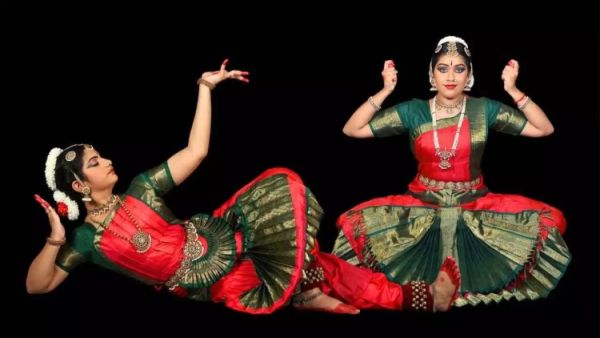
Under the direction of Dr. Smitha Madhav and Smt. Bhargavi Parameswaran, students from Varna Arts Academy performed Bharatanatyam at the three-day Kalasagaram Annual Youth Festival of Dance 2025 last week at Meenakshi Sundaram Hall in Secunderabad. All of the recorded songs played during the event were written, choreographed, and sung by Dr. Smitha Madhav.

Meenakshi Bathula and Akshara Ramakrishnan opened the recital on Thursday with a “Pushpanjali” in honor of Lord Dakshinamurthy. This was followed by an enthralling “Mayura Alarippu” that was modeled after dancing peacocks. Effectively shown were the birds’ distinctive stride and eye-catching fan of tail feathers. There was a resounding “Panchakam” in honor of Jagadguru Chandrasekharendra Saraswathi.
With their elaborate “nritta” and “abhinaya,” the “Varnam” and “Chalamela” vividly captured the dedication, love, and anguish of a devotee attempting to attain Lord Vishnu’s lotus feet. The renowned “Atma Shatakam” by Adi Shankara, which was a fitting homage for Shankara Jayanti, came next, followed by a thrilling “kriti” on Devi Sharada of Sringeri. The last performance, a “Dhanashree Thillana,” was enchanted and effectively brought the beauty and elegance of Lord Krishna to the stage.
The crowd watched the whole lecture with interest. Following this heartfelt encounter, Kalasagaram generously prepared supper for all of the “rasikas.”
The highlight of Saturday was Aditi A’s outstanding 90-minute performance. Notably, very few pupils in Hyderabad of her age and skill level are able to maintain such a lengthy performance with grace and elegance. Her gurus, Smt. Bhargavi and Dr. Smitha, deserve praise for maintaining her style. The seminar began precisely on time since Kalasagaram is quite stringent about being on time.
Aditi was dressed elegantly in a gold and russet “aharya.” Traditionally, Lalgudi Jayaraman’s “Pushpanjali” marked the start of the “Margam.” Since they honor Sridevi and Bhudevi Nachiyar, two “shlokas” from Vedanta Desika’s “Daya Satakam” were gently enunciated and have particular importance. The “Poorvangam’s” “Garuda Alarippu” was delicious. Its theme was the magnificent Eagle Vahana of Lord Vishnu, and it made use of “Sthanaka” and “Mandala Bhedas.” The Venkateswara Suprabhatam extols Vinata’s son.
It was amazing how every trait of the predatory raptor was stylized into a classical dance style. Every position of “Angika Abhinaya” brought the bird to life on stage, including the enormous wings’ unfolding, the beak’s feather-preening motions, the farsighted, acute eyes’ flashes, and the feet’s razor-sharp claws. The pictures seen in temples where the Lord’s “Utsava Vigraha” is carried during festivals served as the inspiration for the evolving “Vahana” stance.
Tulsidas’ “Rudrashtakam” was presented as a sparkling “Kauthuvam.” As she portrayed scenes from Lord Shiva’s life, such as the destruction of Tripuras, the burning of Kamadeva, and his encounters with the “bhaktas,” Aditi’s intensity was exhilarating to see. His physique was described as being of great splendor, with a skull garland, blue throat, swinging earrings, and a sparkling forehead.
The centerpiece was Maharaja Swati Tirunal’s “Bhavayami Raghuramam,” which had appearances from the Ramayana that described each “kandam.” Aditi moved between the roles with ease, including the lordly Rama, the beautiful Sita, the cunning Maricha, the ugly Surpanaka, the angry Ravana, and the loyal Hanuman. As the “Teermanams” were performed with gleam, each “jathi” sequence ended with a return to the position of Lord Rama, beautifully outlined with bow in hand, inspiring cheers.
A beautiful “Keerthanam” in Behag extolled Lord Muruga in a slower pace. Intriguingly, the Lord’s captivating form was further developed by characterizing him as a “Sanyasi” who could enchant even renunciates. The composition was preceded by a Tamil “Virutham.”
A “Charanam” praising the Kanchi Paramacharya was included in the “Basant Bahar Thillana.” Pure “nritta” was lively and vivacious as Aditi moved quickly across the stage. Narayana Bhattadri’s magnificent “Ragamalika” composition, “Agre Pashyami,” brought the show to life. It described the Lord from head to toe and explained his spiritual joy at seeing Guruvayoorappan’s “Vishwaroopa.” Aditi received thunderous praise for her stunning performance in this last piece.
To the delight of the audience, the “Margams” of both days included a carefully chosen assortment of varied elements that demonstrated the young performers’ skill in both emotive “Abhinaya” parts and pure dance routines.